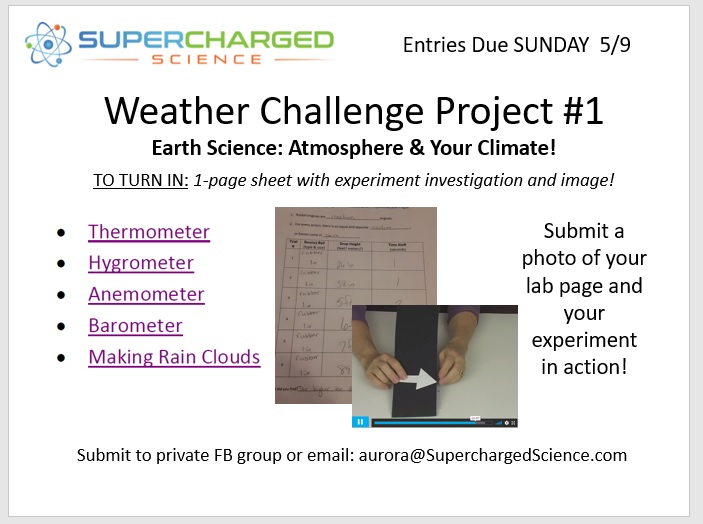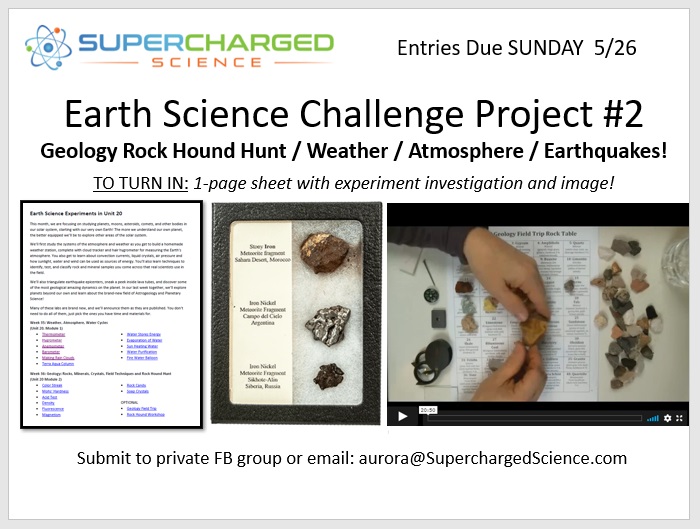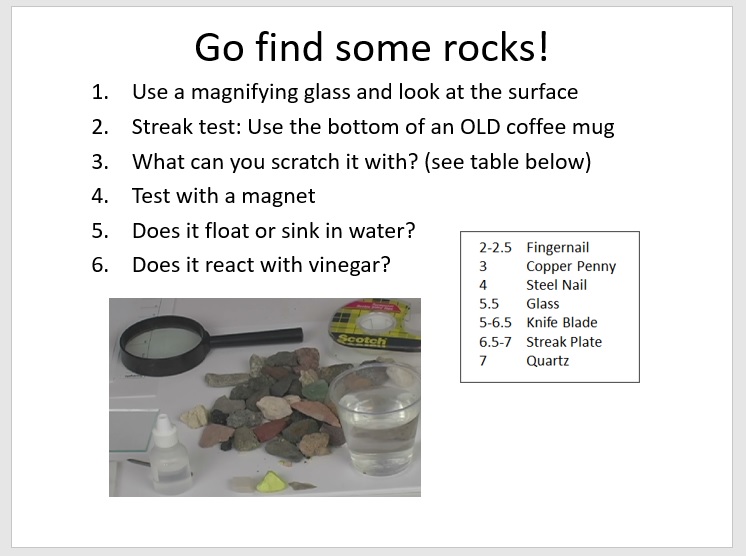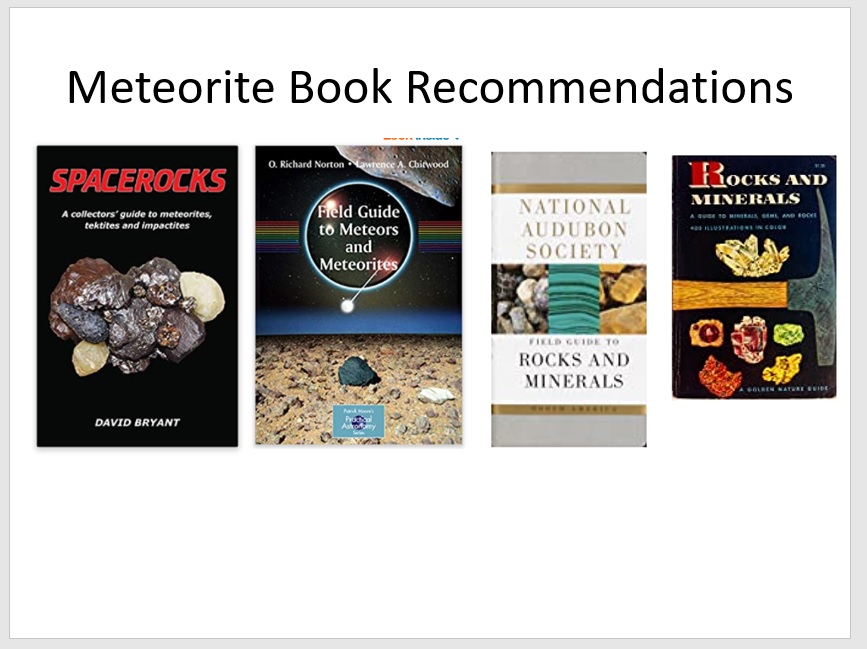[am4show have='p8;p9;p11;p38;p72;p77;p92;' guest_error='Guest error message' user_error='User error message' ]
Week 35: Weather, Atmospheres & Water Cycles
Weather changes so quickly around our planet that pilots can even get a minute-by-minute weather update! We're going to discover how temperature, pressure, humidity, and wind strength all contribute to the weather we experience. Weather is how the Earth moves energy around our planet, and by studying storms, hurricanes, tornadoes and extreme heat conditions can help us better understand changing climate conditions, solar winds and ozone levels.

Join our Science Fair!
We're hosing a Spring Science Fair and you are invited! Watch the video below and click the button for all the details about how you can do a science fair project and show us how you do real science!
Week 36: Geology of Rocks, Minerals, Crystals, Field Techniques and Rock Hound Hunt
We’re about to dive into the big ideas behind rocks, minerals, and the science of geology. Soon you’ll learn how to burn coal, fluoresce minerals, chemically react rocks, streak powders, scratch glass, and play with atomic bonds as they learn how to be a real field geologist. Throughout this week, we’re going to be talking about the chemical composition (what elements rocks are made of), so you’ll really understand chemistry and geology both!


Week 37: Volcanoes, Earthquakes, Tides and Electronic Detectors
Discover the shifting movement of the earth as it moves energy around the interior of our planet! You'll learn how to build electronic detectors to measure temperature, shift, sunlight and more. You'll also explore volcanoes (both above and under water), discover vertical shifting in water and land tides, and learn how to triangulate the epicenter of an earthquake!
Scientists monitor volcanoes by looking at earthquakes, ground movement, volcanic gas, rock chemistry, water chemistry, and use satellites to help them take data and scan continuously or on a real-time basis and they look for changes in these readings.
As magma rises through the crust towards the Earth's surface, it can cause the crust to move and bulge. This movement or deformation can be detected by using seismographs (there's a video on how to build one of these this week!) which measure the Earth's movement, so they are an important tool for studying whether a volcano might erupt in the near future.
If a scientist wants to take a sample from a volcano, they approach the volcano from upwind, making sure they wear special protective gear (from head to toe) and they will carry a hammer and pick-ax along with a bucket of water so they can place their samples to cool.
Lava is what we call melted rock above the surface. It's "magma" below the surface. The lave can be 2,000 deg Fahrenheit, so they use special tools to handle it without getting burned. After they plunk it in the water, the geologists bring the samples back to their labs.
Special Guest: Dr. Rosaly Lopes, Senior Volcano Scientist at NASA JPL
Dr. Rosaly Lopes, a volcanologist at the Jet Propulsion Laboratory (JPL), began her college studies in astrophysics but was soon inspired to study volcanoes on Earth and in space. She knew from when she was seven years old that she wanted to be an astronaut and work for NASA.
Her first job at JPL was with the Galileo spacecraft that flew by Venus to study the volcanic features of Jupiter’s moon Io. She has worked on the Cassini mission to Saturn studying data captured by Cassini about the moon Titan.
By studying volcanoes in space, we can better understand volcanoes on Earth because other planets have other variations like different gravitational fields and atmospheres. Dr. Lopes has visited over 50 volcanoes and has written seven books including a guidebook that describes every volcano on our planet.
Editor's note: please ignore the small echo near the end of Dr. Lopes' presentation. We were able to clean up most of it, just not the last bit.)
Earth Science Electronic Detectors
The electronic detectors below are for upper level students. If you haven't yet completed the first section of Unit 14, I recommend working on those first before doing the projects below. We covered electronics back a couple of months ago in Mechanical Engineering month, so please review content as needed before moving into the projects below.
STUDENTS: You will need to start with the basic Breadboard Circuits here before doing the Earth Science Detectors videos below.
Light Listener
In this project, we’ll build a project to listen to pulses of light that come from fluorescent bulbs and other sources. We’ll use two integrated circuits (IC) called operational amplifiers to increase the signal from a phototransistor. We can then listen to that signal by using a speaker. Download schematic here.
Monitor Sunlight
In this project, we’ll build a circuit to measure light from the sun and other sources. We’ll use an integrated circuit (IC) called an operational amplifier to increase the voltage from a solar cell and measure the output using a multimeter. Download schematic here.
Earth Movement Sensor
In this project, we’ll build a circuit to detect the motion of a magnet. We’ll use an integrated circuit (IC) called an operational amplifier to light up an LED when a magnet moves over a coil. Download schematic here.
Sun Photometer
In this project, we’ll build a circuit to measure light using a LED. We’ll use an integrated circuit (IC) called an operational amplifier to increase the tiny voltage caused when light hits an LED. Download schematic here.
LED Telemetry Transmitter
In this project, we’ll build a circuit to measure temperature using a special kind of resistor called a thermistor. We’ll use a special integrated circuit (IC) called the 555 timer to change the blink rate of an LED based on temperature. Download schematic here.
Electronic Cricket
In this project, we’ll build a circuit to measure temperature using a special kind of resistor called a thermistor. We’ll use an integrated circuit (IC) called the 555 timer to change the rate of “chirps” based on temperature. Download schematic here.
Week 38: Exogeology: A Special New Area of Science
(also called "Planetary Science" or "Astrogeology"
(This is the study of geology on other planets, comets, asteroids, moons and more!)
We're going to look at the latest data and research scientists are conducting on space missions and learn about the structure and composition of planets and other bodies in the solar system, like comets, asteroids, meteorites, and more! It's such a new area of science that currently has several different names that all mean the same thing: Planetary Geology, Astrogeology and Exogeology.
Field Trip: Meteorite Lab!
Join me for a tour inside the private collection of metallurgist engineer Dave Gibbs and he shares his passion for metals and meteorites with us in this special class! This presentation is about an hour and a half, so I've broken it down into smaller segments so you can go at your own pace.
Please watch the videos in order, starting with #1. After the videos, you'll find a set of downloads where you can learn more about meteorites, find pocket microscopes and book recommendations. Enjoy this special class!

[/am4show]
